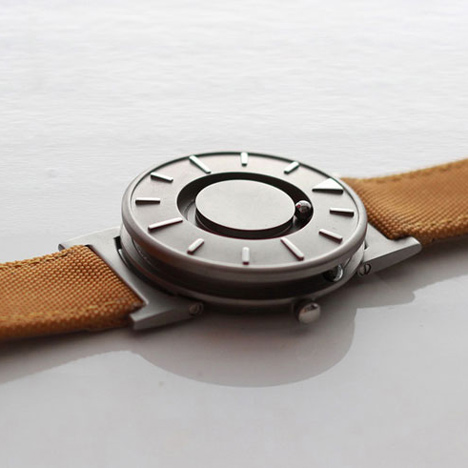
The Bradley timepiece for blind people proves inclusive design has wide appeal
A tactile watch designed for blind people by a group of students has gone into production after strong demand from sighted consumers (+ interview).
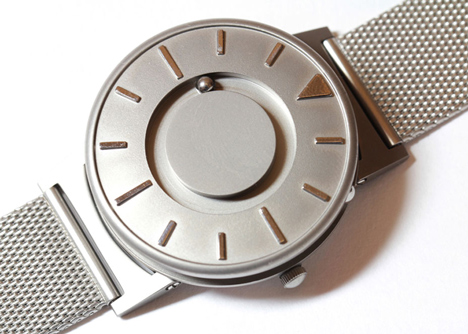
The Bradley watch, which displays the time via a ball bearing that moves around the face, has also emerged as a frontrunner for the Design of the Year 2014 award, organised by the Design Museum in London.
"It's a tactile watch that was designed with users who are blind in mind," said David Zacher, lead designer at Eone, a company established to manufacture and sell the watch.
"We started out thinking about what kind of watch would work for blind users and we struck upon this idea of using ball bearings rotating around a track to indicate the minutes and the hours on the dial," Zacher told Dezeen at last night's Designs of the Year 2014 exhibition launch:
The product was developed by Zacher as a side project while studying industrial design at RISD in collaboration with other students, but it will go on sale in June after a successful Kickstarter funding drive showed that non-visually impaired consumers wanted to buy the watch.
"A majority of the responses don't have anything to do with vision impairment," said Amanda Sim, a former RISD graphic design student who is now head of graphic design and marketing for Eone. "People just think it’s a beautiful and eye-catching watch."
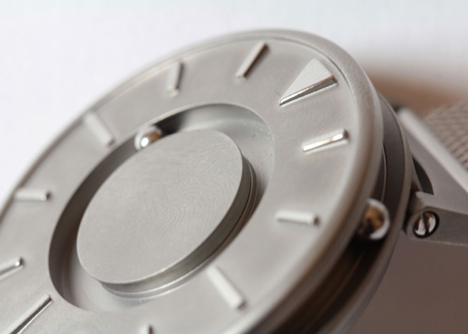
The idea for the watch came from research showing that partially sighted and blind people were buying designer timepieces they couldn't use and then using their phone to tell the time or relying on obtrusive talking watches.
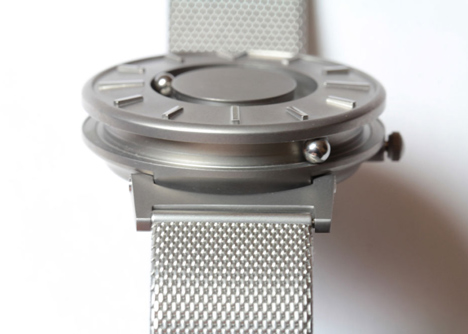
The product is now being marketed as a "gentleman's watch" that is "built for discretion" - since wearers can check the time without anyone noticing.
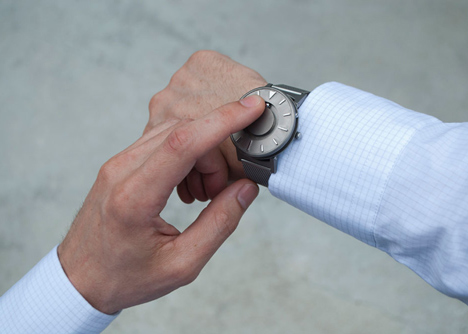
Zacher described the process of designing the watch as "the Eames model" and said his team would embark on more "inclusive design" projects in future.
"We never would have hit on this idea of using ball bearings to tell time if we hadn’t been solving [the problem of designing a watch for the visually impaired]," he said. "So I can see a broader application in products that follows that same approach, of inclusively designing something."
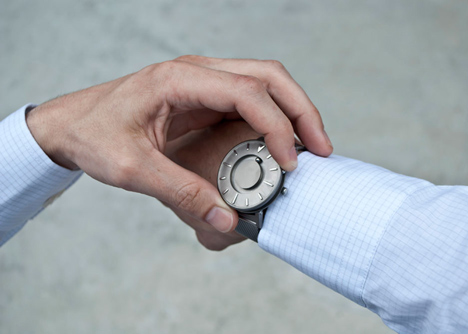
The Bradley is named after Bradley Snyder, an ex-naval officer who lost his eyesight in an explosion in Afghanistan in 2011 and who went on to win gold and silver medals at the London 2012 Paralympic Games.
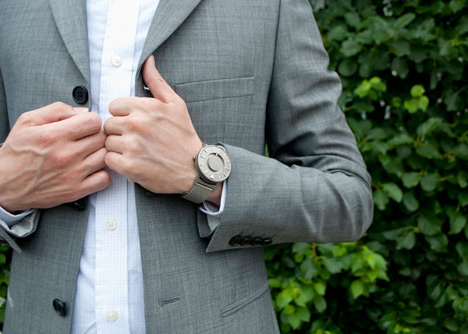
A magnet inside the titanium watch moves a ball bearing around the track. Because the bearing is raised, wearers can feel its position with their fingers.
You can register your interest in purchasing The Bradley with us today on the Dezeen Watch Store blog, and we will contact you as soon as we can confirm a shipping date.
Dezeen is media partner for Designs of the Year. Readers can get 25% off the regular admission price when booking online.
Below is an edited transcript of the interview with David Zacher and Amanda Sim of Eone:
Marcus Fairs: Tell us what this product is and how the idea came about.
David Zacher: It's a tactile watch that was designed with users who are blind in mind. We started out thinking about what kind of watch or time keeping device would work for blind users and we struck upon this idea of using ball bearings rotating around a track to indicate the minutes and the hours on the dial.
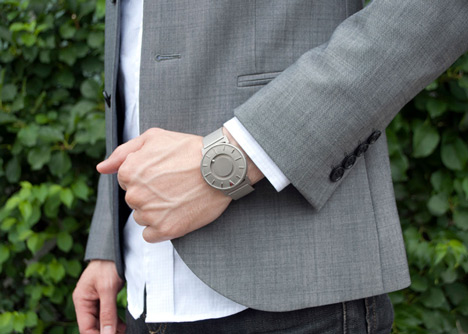
Marcus Fairs: I heard you saying before how blind people would buy fashionable watches and then listen to Siri reading out the time.
David Zacher: We did a tremendous amount of user research. We found users who had a talking watch which is quite loud and a little embarrassing to use in a public place like a classroom say. So that was one piece of intel that we gained and as we went further into it we found users who were wearing fashion watches, even though they couldn’t tell the time. They were using their iPhones to tell the time. So we thought about how we can make a fashionable watch that would also work for tactile users and hopefully appeal to a larger audience of everyday users.
Amanda Sim: The watch is built from solid titanium. It comes in a range of different watch bands in stainless steel as well as canvas and leather. It’s built for durability, it's easier to clean, easier to fix, but we’re marketing it as the gentleman’s watch. So it’s built for discretion and it’s all about the modern man who needs to be couth and gentlemanly but somehow always knows where he needs to be and what time it is.
Marcus Fairs: So he can check whether he needs to leave without letting anyone know.
Amanda Sim: Exactly.
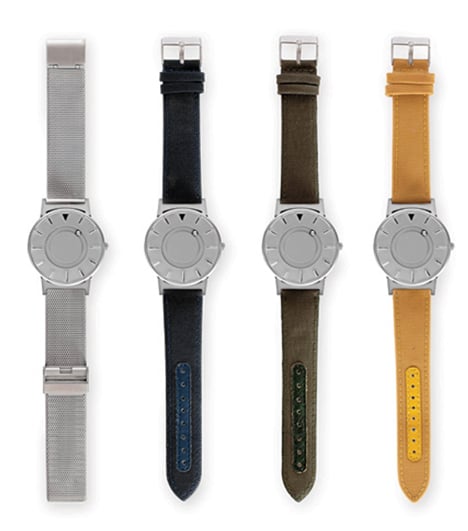
Marcus Fairs: So you developed this when you were at RISD. Is that right?
Amanda Sim: Yes in graduate school, at the Rhode Island School of Design. We were approached by Hyungsoo Kim, a graduate of MIT Sloan School of Management, who founded Eone Timepieces and is very much interested in projects for social good. But Eone is a for-profit company because we believe the proceeds of what we make from this watch can be fed into improving innovation and products for impaired users.
David Zacher: And we worked really hard to try and keep the price-point of it as low as possible. To keep it as accessible as we possibly can. That’s where we see the social bit.
Marcus Fairs: Where is it at in terms of development? Is it a product that is available and ready for order?
David Zacher: We recently finished fulfilment on our Kickstarter orders so it's in production and it's currently available for preorder in the UK, US and Canada with delivery in June.
Amanda Sim: But in June it will be available in Hong Kong, Taiwan, the Philippines, South Korea, the US, Canada and throughout Europe.
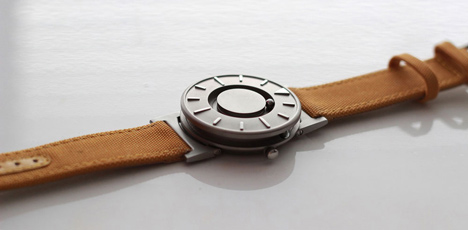
Marcus Fairs: And what has been the response so far from blind people and non-blind people?
David Zacher: Oh it's been wonderful. We've gotten great response from all over the world from our Kickstarter funders and the community that has come to support us has been amazing.
Amanda Sim: And a majority of the responses don't have anything to do with vision impairment. People just think it’s a beautiful and eye-catching watch.
Marcus Fairs: Do you think this is a kind of philosophy that could be expanded, designing things for people with some kind of impairment but aimed at a wider market?
David Zacher: Definitely, we never would have hit on this idea of using ball bearings to tell time if we hadn’t been solving for that problem, so I can see a broader application in products that follows that same approach, of inclusively designing something.
If you respect the user group you are designing for and you are keeping in mind that you are trying to design something that is superb not just for that user group but for mainstream use, I think that the result is exemplary design and the key word that always comes around in our design critiques is 'inclusive design'. It’s all about the best, for the most, for the least. It's the Eames model.